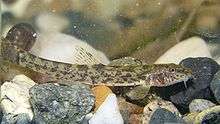Stone loach
| Stone loach | |
|---|---|
 | |
| Scientific classification | |
| Kingdom: | Animalia |
| Phylum: | Chordata |
| Class: | Actinopterygii |
| Order: | Cypriniformes |
| Family: | Nemacheilidae |
| Genus: | Barbatula |
| Species: | B. barbatula |
| Binomial name | |
| Barbatula barbatula (Linnaeus, 1758) | |
| Synonyms | |
|
Nemacheilus barbatulus | |
The stone loach (Barbatula barbatula) is a species of fresh water ray-finned fish in the Balitoridae family. It is one of seventeen species in the genus Barbatula.
It is found in Baltic states, Eastern Europe, Austria, Belgium, Bulgaria, Czech Republic, Denmark, Finland, France, Germany, Hungary, Ireland, Italy, Liechtenstein, Luxembourg, Moldova, the Netherlands, Poland, Romania, Serbia and Montenegro, Slovakia, Spain, Sweden, Switzerland, and the United Kingdom.
Stone loaches live amongst the gravel and stones of fast flowing water where they can search for food. The most distinctive feature of this 14 cm fish is the presence of barbels around the bottom jaw, which they use to detect their invertebrate prey. The body is a mixture of brown, green and yellow.
Description
The stone loach is a small, slender bottom-dwelling fish growing to a length of about 14 cm (6 in). Its eyes are situated high on its head and it has three pairs of short barbels on its lower jaw below its mouth. It has a rounded body that is not much laterally flattened and is a little less deep in the body than the spined loach (Cobitis taenia) and lacks that fish's spines beneath the eye. It has rounded dorsal and caudal fins with their tips slightly notched, but the spined loach has even more rounded fins. The general colour of this fish is yellowish-brown with blotches and vertical bands of darker colour. An indistinct dark line runs from the snout to the eye. The fins are brownish with faint dark banding.[2]
Distribution and habitat
The stone loach is a common species and is found over most of Europe in suitable clear rivers and streams with gravel and sandy bottoms. It is present in upland areas, also chalk streams, lakes and reservoirs as long as the water is well-oxygenated. These fish sometimes venture into estuaries but not into brackish water. They live on the bottom, often partly buried, and they are particularly active at night when they rootle among the sand and gravel for the small invertebrates on which they feed.[2]
References
- ↑ J. Freyhof & M. Kottelat (2008). "Barbatula barbatula". IUCN Red List of Threatened Species. Version 2009.2. International Union for Conservation of Nature. Retrieved February 9, 2010.
- 1 2 "Stone loach: Barbatula barbatula (L.)". NatureGate. Retrieved 2013-12-25.
External links
![]() Media related to Barbatula barbatula at Wikimedia Commons
Media related to Barbatula barbatula at Wikimedia Commons
Froese, Rainer and Pauly, Daniel, eds. (2006). "Barbatula barbatula" in FishBase. April 2006 version.
